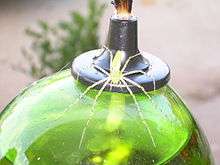Peucetia viridans
| Green lynx spider | |
|---|---|
| | |
| Scientific classification | |
| Kingdom: | Animalia |
| Phylum: | Arthropoda |
| Class: | Arachnida |
| Order: | Araneae |
| Suborder: | Araneomorphae |
| Family: | Oxyopidae |
| Genus: | Peucetia |
| Species: | P. viridans |
| Binomial name | |
| Peucetia viridans (Hentz, 1832) | |
| Synonyms | |
|
Sphasus viridans | |
Peucetia viridans, the green lynx spider, is a bright-green lynx spider usually found on green plants. It is the largest North American species in the family Oxyopidae.
Description
The body of the female may be as much as 22 millimeters (0.87 in) long. The male is smaller, being slenderer and averaging 12 millimeters (0.47 in) in length. There often is a red patch between the eyes, with a few red spots on the body. The eye region is clothed with white appressed hairs. The dorsal surface of the abdomen bears about six Chevron-like marks with the centres pointing forward. The legs are green to yellow, bearing long black spines such as appear on the legs of most species of Oxyopidae, and with a generous scattering of black spots. Peucetia viridans is confusingly similar to Peucetia longipalpis, the other Peucetia species to occur in the United States, but Peucetia longipalpis tends to have a shorter, fatter, more domed abdomen, with less pronounced markings in its upper surface.
Late in the season Peucetia viridans is prone to change its colour from predominantly green to paler yellow, typically with streaks of reddish, suggesting degradation of the tetrapyrrole pigment in the blood. Gravid females may change their color to fit their background. This takes about 16 days.[1]
Habits
The female constructs one to five 2-centimeter (0.8 in) egg sacs in September and October, each containing 25 to 600 bright orange eggs, which she guards, usually hanging upside down from a sac and attacking everything that comes near. Remarkably, one of her means of defense is to squirt venom from her chelicerae, sometimes for a distance of about a foot (300 mm).[2] The eggs hatch after about two weeks, and after another two weeks fully functional spiderlings emerge from the sac. They pass through eight instars to reach maturity.
Human interest
The green lynx spider very seldom bites humans, and when it does, its venomous bite, though painful, is not deadly [3] but may cause surrounding (edema) swelling up to 7"-10" in diameter.[4]
The species is primarily of interest for its usefulness in agricultural pest management, for example in cotton fields. The spiders have been observed to hunt several moth species and their larvae, including some of the most important crop pests, such as the bollworm moth (Heliothis zea), the cotton leafworm moth (Alabama agrillacea), and the cabbage looper moth (Trichoplusia ni). However, they also prey on beneficial insects, such as honey bees.[5]
Distribution

This species occurs in the southern United States, some parts of Northern California, Central America, the West Indies, and Venezuela.
Name
The species name, viridans, is Latin for "becoming green". It should not be confused with either P. viridana, a species that occurs only in India and Myanmar, or P. viridis from Spain and Africa.
 Peucetia viridans, Female, Mason Regional Park, Irvine CA
Peucetia viridans, Female, Mason Regional Park, Irvine CA Peucetia viridans, Female, Mason Regional Park, Irvine CA
Peucetia viridans, Female, Mason Regional Park, Irvine CA Green lynx spider, Chesapeake, VA
Green lynx spider, Chesapeake, VA.jpg) Male Green Lynx Spider, Chesapeake, VA
Male Green Lynx Spider, Chesapeake, VA Green Lynx vs Pisauridae, IN
Green Lynx vs Pisauridae, IN Green Lynx spider in our garden, Big Bear City, CA 92314
Green Lynx spider in our garden, Big Bear City, CA 92314
 On a rose in Tyler, Texas
On a rose in Tyler, Texas
References
- ↑ Oxford GS, Gillespie RG (1998). "Evolution and ecology of spider coloration". Annual Review of Entomology. 43: 619–43. doi:10.1146/annurev.ento.43.1.619. PMID 15012400.
- ↑ Fink LS. 1984. Venom spitting by the green lynx spider, Peucetia viridans (Araneae, Oxyopidae). Journal of Arachnology 12: 373-4.
- ↑ Williams, Dan. "Green Lynx Spider". Survive Outdoors.com. Survive Outdoors, Inc. Retrieved 1 September 2009.
- ↑ Bush SP, Giem P, Vetter RS (2000). "Green lynx spider (Peucetia viridans) envenomation". American Journal of Emergency Medicine. 18 (1): 64–6. doi:10.1016/S0735-6757(00)90052-4. PMID 10674536.
- ↑ Weems, H. V., Jr. and Whitcomb, W. H. Green Lynx Spider, Peucetia viridans (Hentz) (Arachnida: Araneae: Oxyopidae). EENY-249 Entomology and Nematology Department, Florida Cooperative Extension Service, Institute of Food and Agricultural Sciences, University of Florida. Published: November 2001. Revised March 2011
- Green lynx spider on the UF / IFAS Featured Creatures Web site
External links
-
 Data related to Peucetia viridans at Wikispecies
Data related to Peucetia viridans at Wikispecies -
 Media related to Peucetia viridans at Wikimedia Commons
Media related to Peucetia viridans at Wikimedia Commons